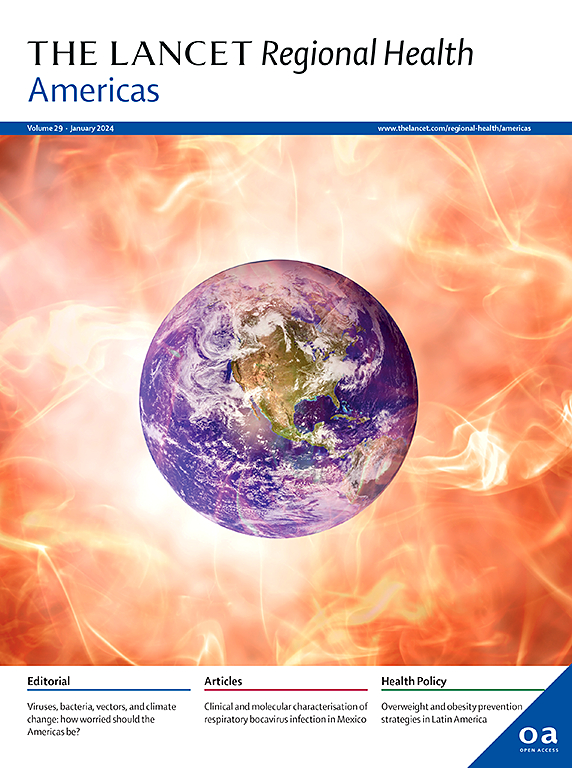2018-2022年巴拉圭土著人口中结核病的集中:一项基于人口的回顾性研究
IF 7
Q1 HEALTH CARE SCIENCES & SERVICES
引用次数: 0
摘要
背景在过去十年中,全球结核病发病率有所下降,但巴拉圭的发病率却有所上升。2018年实施的新报告系统以前从未用于描述结核病趋势和确定扩大结核病诊断和治疗规划可及性的优先领域。方法对2018 - 2022年巴拉圭国家结核病控制规划(NPTC)上报的所有结核病病例进行回顾性研究。我们量化了病例通报在空间上的趋势,以及在国家预防疟疾委员会确定为易感人群中的趋势,并测量了获得GeneXpert检测的趋势。在巴拉圭2018年至2022年报告的13725例结核病病例中,2337例(17%)发生在被监禁的个体中,1743例(12.7%)发生在自我认定的土著个体中。2022年,与未被剥夺自由者和非土著人口相比,被剥夺自由者和土著人口中结核病的相对风险分别为87和6.39 (95% CI: 6.08-6.72)。我们发现巴拉圭17个省的结核病发病率存在显著的异质性。虽然土著人口中45%的结核病病例发生在巴拉圭西部的查科地区,但首都(包括大都市区)土著人口的通报率最高(每10万人中有1127.4例)。结核病病例集中在巴拉圭的被监禁者和土著人口中,这两种人群都有极高的结核病相对风险。我们的研究结果强调了在全国范围内,特别是在结核病高风险人群中扩大结核病诊断、治疗和预防的可及性的紧迫性。资助k01ai173385 (NIH, NIAID),犹他大学UROP。本文章由计算机程序翻译,如有差异,请以英文原文为准。
The concentration of tuberculosis within Paraguay’s Indigenous population, 2018–2022: a retrospective population-based study
Background
While over the past decade global incidence rates of tuberculosis (TB) have decreased, in Paraguay incidence has risen. A new reporting system implemented in 2018 has not previously been used to characterise trends in TB and identify areas to prioritise for the expansion of access to TB diagnostics and treatment programmes.
Methods
We conducted a retrospective study of all TB cases notified to the Paraguay National Program for Tuberculosis Control (NPTC) from 2018 to 2022. We quantified trends in case notifications spatially and in specific populations identified as vulnerable by the NPTC and measured trends in access to GeneXpert testing.
Findings
Of the 13,725 TB cases notified in Paraguay from 2018 to 2022, 2337 (17%) occurred among incarcerated individuals and 1743 (12.7%) occurred among self-identified Indigenous individuals. In 2022, the relative risk of TB was 87 and 6.39 (95% CI: 6.08–6.72) among persons deprived of liberty and Indigenous populations, compared to those who are not persons deprived of liberty and non-Indigenous populations respectively. We found significant heterogeneity in TB incidence across Paraguay’s 17 departments. While 45% of TB cases among the Indigenous population occurred in the Chaco Region, in western Paraguay, notification among the Indigenous population was highest (1127.4 per 100,000) in the Capital, including the metropolitan area.
Interpretation
TB cases are concentrated among Paraguay’s incarcerated and Indigenous populations, both of which have extremely high relative risk of TB. Our findings highlight the urgency of expanding access to TB diagnosis, treatment, and prevention across the country and specifically, to the populations at heightened risk of TB.
Funding
K01AI173385 (NIH, NIAID), University of Utah UROP.
求助全文
通过发布文献求助,成功后即可免费获取论文全文。
去求助
来源期刊

Lancet Regional Health-Americas
Multiple-
CiteScore
8.00
自引率
0.00%
发文量
0
期刊介绍:
The Lancet Regional Health – Americas, an open-access journal, contributes to The Lancet's global initiative by focusing on health-care quality and access in the Americas. It aims to advance clinical practice and health policy in the region, promoting better health outcomes. The journal publishes high-quality original research advocating change or shedding light on clinical practice and health policy. It welcomes submissions on various regional health topics, including infectious diseases, non-communicable diseases, child and adolescent health, maternal and reproductive health, emergency care, health policy, and health equity.
 求助内容:
求助内容: 应助结果提醒方式:
应助结果提醒方式:


